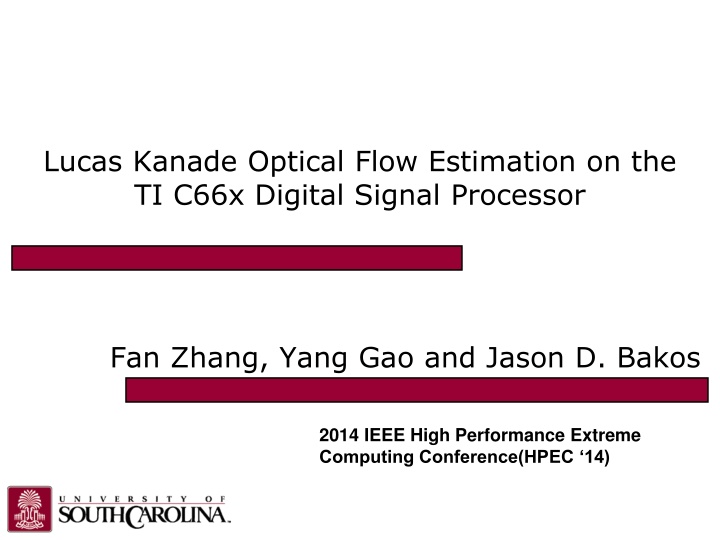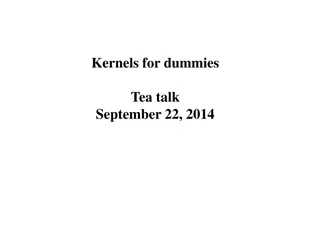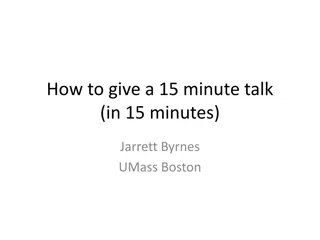
Optical Flow Estimation on TI C66x DSP: Methodologies & Architectural Features
Explore the Lucas-Kanade optical flow estimation methodology on the TI C66x DSP, detailing its unique features, multi-core architecture, and why DSP is preferred for tasks like computer vision. Discover the gradient-based optical flow solver and the Lucas-Kanade method, along with image derivative computation techniques used. Uncover how this approach evaluates pixel movement in videos and its applications in real-time scenarios like robotic vision and augmented reality.
Download Presentation

Please find below an Image/Link to download the presentation.
The content on the website is provided AS IS for your information and personal use only. It may not be sold, licensed, or shared on other websites without obtaining consent from the author. If you encounter any issues during the download, it is possible that the publisher has removed the file from their server.
You are allowed to download the files provided on this website for personal or commercial use, subject to the condition that they are used lawfully. All files are the property of their respective owners.
The content on the website is provided AS IS for your information and personal use only. It may not be sold, licensed, or shared on other websites without obtaining consent from the author.
E N D
Presentation Transcript
Lucas Kanade Optical Flow Estimation on the TI C66x Digital Signal Processor Fan Zhang, Yang Gao and Jason D. Bakos 2014 IEEE High Performance Extreme Computing Conference(HPEC 14)
What is Optical Flow Evaluates the pixel movement in video stream Represented as a dense 2D fields Many applications need to apply real-time optical flow Robotic vision Augmented reality Computationally intensive 2
TI C66x Multicore DSP Unique architectural features Eight cores Statically scheduled VLIW/SIMD instructions 2 register files and 8 functional units per core Tesla K20X GPU Intel i7 Ivy Bridge TI C6678 Keystone NVIDIA Tegra K1 Server GPU Server CPU Embedded Embedded Peak single precision throughput 3.95 Tflops 448 Gflops 160 Gflops 327 Gflops Peak Power 225 W 77 W <10 W <20 W DRAM 250 GB/s 25.6 GB/s 12.8 GB/s 17.1 GB/s bandwidth 3
Why using DSP? Low power consumption High performance floating point arithmetic Strong potential for computer vision tasks 1D vs 2D (signal processing vs image processing) 4
Gradient-based Optical Flow Solver . Frame t + t . Optical flow evaluation (x + x, y + y, t + t) (x, y, t) First-order approximation Frame t Gradient of pixel in x, y and t direction, known One formula with two unknowns Optical flow, unknown 5
Lucas Kanade Method If we assume the pixel adjacent to the center has the same optical flow as the center ( , 1 ) 1 ( , 1 ) 1 ( , 1 ) 1 f x y f x y f x y x-1,y-1 x-1,y x-1,y+1 x,y-1 x,y x,y+1 x+1,y-1 x+1,y x+1,y+1 + = v v x y x y ... t + + + + + + ( , 1 ) 1 ( , 1 ) 1 ( , 1 ) 1 f x y f x y f x y + = v v x y x y t ( , 1 ) 1 ( , 1 ) 1 f x y f x y ( , 1 ) 1 f x y , ... x y t = b = Let ... A + + ( , 1 ) 1 f x y + + + + ( , 1 ) 1 ( , 1 ) 1 f x y f x y , t x y 2 f f f f f V f x x y x t x = = 1 T T ( ) A A A b Least Square Method f f 2 V f f y y t x y y 6
Image Derivative Computation f A B = (A B + C D) / 2 x C D frame n f A B = (A C + B D) / 2 y C D frame n f = A B A - B t frame n+1 frame n 7
Lucas Kanade Method Input: Frame n, frame n+1, window size w Output: Optical flow field F For each pixel x, y Compute x,y,t derivative matrices Dx, Dy, Dt for its neighbor window Compute optical flow by the least square method 8
Derivative Computation (Example) 10 10 10 10 10 30 10 10 10 10 10 10 10 10 10 10 10 10 10 10 10 10 10 10 10 10 30 10 10 10 10 10 Image n Image n + 1 -10 -10 0 10 10 0 0 0 0 -10 -10 0 10 10 0 0 0 0 0 0 20 0 0 0 -20 0 0 f f f y x t 9
Least Square Method Example (Neighbor Window Size = 3) f f -10 -10 0 10 10 0 0 0 0 -10 -10 0 10 10 0 0 0 0 0 0 20 0 0 0 -20 f 0 0 t y x 2 f f f W W W = = 200 400 y t x f f = 0 1 x y 400 0 200 Vx = 2 0 400 200 Vy f W = 400 y f f W = 200 x t 10
Optimize Lucas Kanade Method on DSP Derivative computation SIMD arithmetic Data interleaving Least square method Loop unrolling SIMD load & arithmetic 11
Derivative Computation 10 10 10 10 10 30 10 10 10 10 10 10 10 10 10 10 Derivative Computation (Dx, Dy) Cycle 1 -10 -10 0 10 10 0 0 0 0 -10 -10 0 10 10 0 0 0 0 Cycle 2 Interleave 10 10 0 -10 -10 0 -10 10 0 -10 10 0 0 0 0 0 0 0 Cycle 3 12
Least Square Method Required computations Dx Multiplication x 5 Dy Dt Accumulation x 5 DxDx DxDy DyDy DxDt DyDt Map to device Dx Dy Dt Dt Complex Mul 2-way SIMD Mul DxDy DyDx -DyDy DxDx DxDt DyDt (a+bj)(c+dj) = (ac-bd) + (ad+bc)j 13
Least Square Method Unrolled 2x Group up loads into SIMD operation Load DxDy Load Dt Complex MUL SIMD MUL SIMD ADD DxDy Dt -10 -10 0 -10 10 0 10 10 0 -10 10 0 0 0 0 0 0 0 0 0 0 0 20 0 0 0 -20 200 0 200 0 0 0 (Dx,Dy,Dt) -10 -10 0 -10 -10 200 0 200 0 (DxDx,DxDy,DyDy,DxDt,DyDt) 100 100 100 100 100 100 0 0 0 0 0 + (Dx,Dy,Dt) (DxDx,DxDy,DyDy,DxDt,DyDt) 100 -100 100 100 -100 100 10 10 -10 0 -10 0 0 0 0 0 14
Loop Flattening Software Pipelining TI s compiler technique to allow independent loop iterations be executed in parallel The consecutive iterations are packed and executed together so that the arithmetic functional units are fully utilized for (i = 0; i < m; ++i) for (j = 0; j < n; ++j) Update i, j; for (k = 0; k < m * n; ++k) j = 0 j = 1 j = 0 j = 1 Pipeline prologue/epilogue overhead 15
Multicore Utilization Core 0 Core 1 Core 2 Derivative Computation Least Square Method Least Square Method Least Square Method k = numRows / numCores Row [0, k) Row [k, 2k) Row [2k, 3k) Cache sync 16
Accuracy Improvement Cannot catch movement larger than window size Gaussian Pyramid A coarse to fine strategy for optical flow computation Catches large movements First order approximation may not be accurate Iterative refinement Iteratively process and offset pixels until the computed optical flow is converged Introduce data random access 17
Experiment Setup Platform #Cores Implementation Power Measurement TI C6678 DSP 8 Our Implementation TI GPIO-USB Module ARM Cortex A9 2 Our Implementation YOKOGAWA WT500 Power Analyzer Intel RAPL Intel i7-2600 4 Our Implementation Tesla K20 GPU 2688 OpenCV NVIDIA SMI 18
Results and Analysis Highest Performance Tesla K20 Lowest Power Cortex A9 Best Power Efficiency TI C66x DSP Platform Actual Gflops/ Peak Gflops Gflops C66x 12% CortexA9 7% Intel i7-2600 4% K20 3% 15.4 0.7 17.1 108.6 Power (W) 5.7 4.8 52.5 79.0 Gflops/W 2.69 0.2 0.3 1.4 19
Results and Analysis We achieve linear scalability on multi-cores The power efficiency of the DSP is low when its cores are partially utilized Static power consumption 20
Results and Analysis Performance are related with window size Software pipeline performance Loop flattening is able to improve performance significantly on small window size 21
Conclusion First research work on DPS accelerated Lucas Kanade method Achieve higher energy efficiency and device utilization than GPU and CPU 22
Q & A 23
Kernels of Pyramidal Lucas Kanade Method Gaussian Blur 28flop/pixel Derivative Computation Window Size = 16, Pyramid Level = 4, Iteration = 10 8flop/pixel 105 flop/pixel Least Square Method Flow Field Bilinear Interpolation 3flop/pixel 24






















